Iran Breaches Anglo-Zionist Defenses in Historic Attack: A Breakdown
SIMPLICIUS
Iran made history yesterday by launching “Operation True Promise”. In our usual style here, let’s cut through all the noise currently clogging up social networks and incisively demonstrate the facts as thoroughly as possible, while also pointing out how this was a game-changing and historic event which has brought Iran onto the world stage in a big way.
Firstly, as establishment, Iran’s stated goal for the operation was to strike back at the bases from which the Israeli consular attack was launched on April 1:
IRGC has listed its objectives for last nights missile attack: Ramon and Nevatim airbases (where attack on Iran Consulate was conducted from). Israeli Air Force intelligence HQ in Tel Aviv (where attack on Iran Consulate was planned) and degrading of Israeli air defence radars and assets.
The footage is of the Intelligence HQ getting hit. I have yet to see evidence of 99% interception. Ramon has been badly hit. Nevatim was hit by more than 7 missiles. Air Force Intelligence HQ completely leveled. Other strikes on air defence installations obviously not close to population centres and out of view but I’m sure sat intel will show extent of damage.
And another:
➖Nevatim Airbase in the south of occupied Palestine
➖Ramon Airbase in the south of occupied Palestine
➖The Israeli top-secret intelligence-spy base in Jabal al-Sheikh (Mount Hermon) in the north of the occupied Golan
It should be noted that the rest of the explosions or hits in other areas of the occupied territories are related to the confrontation of the Israeli air defense systems with the projectiles in the sky or the falling of the wreckage of the interceptor missiles or the wreckage of Iranian missiles.
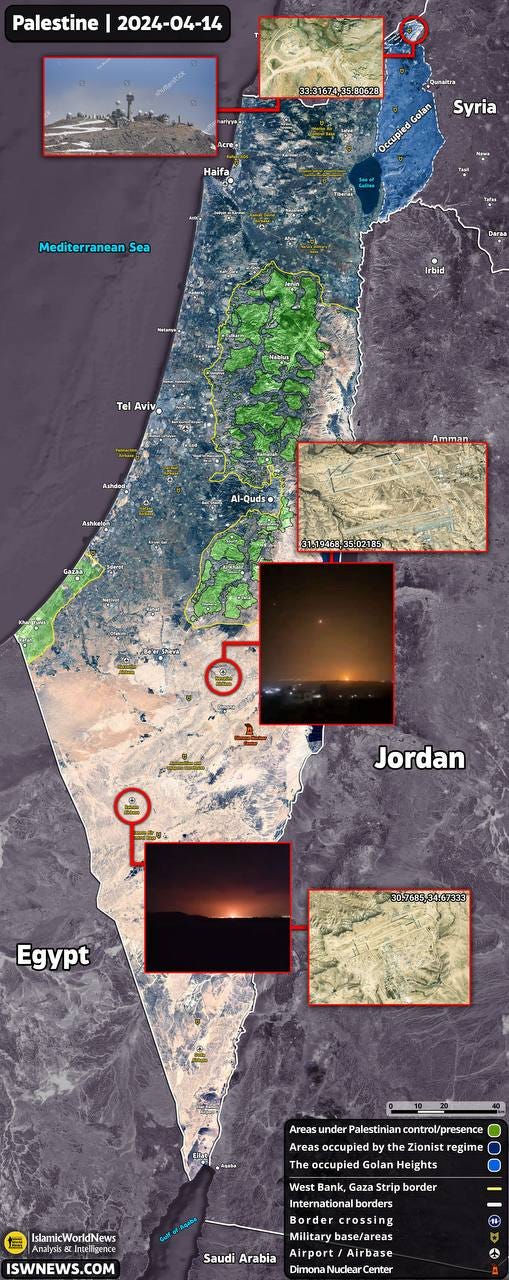
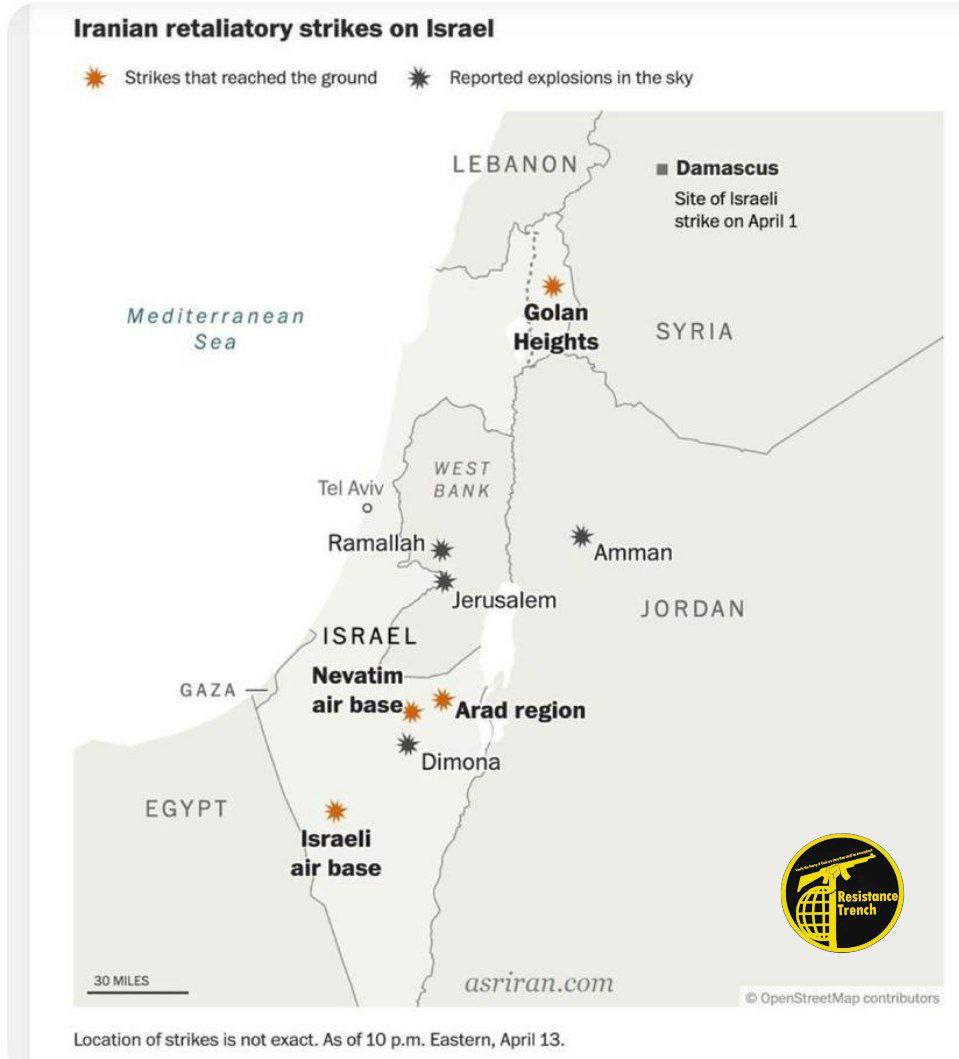
Now, let’s get down to the nuts and bolts.
This strike was unprecedented for several important reasons. Firstly, it was of course the first Iranian strike on Israeli soil directly from Iranian soil itself, rather than utilizing proxies from Iraq, Syria, Lebanon, Yemen, etc. This alone was a big watershed milestone that has opened up all sorts of potentials for escalation.
Secondly, it was one of the most advanced and longest range peer-to-peer style exchanges in history. Even in Russia, where I have noted we’ve seen the first ever truly modern near-peer conflict, with unprecedented scenes never before witnessed like when highly advanced NATO Storm Shadow missiles flew to Crimea while literally in the same moments, advanced Russian Kalibrs flew past them in the opposite direction—such an exchange has never been witnessed before, as we’ve become accustomed to watching NATO pound on weaker, unarmed opponents over the last few decades. But no, last night Iran upped the ante even more. Because even in Russia, such exchanges at least happen directly over the Russian border onto its neighbor, where logistics and ISR is for obvious reasons much simpler.
But Iran did something unprecedented. They conducted the first ever modern, potentially hypersonic, assault on an enemy with SRBMs and MRBMs across a vast multi-domain space covering several countries and timezones, and potentially as much as 1200-2000km.
Additionally, Iran did all this with potentially hypersonic weapons, which peeled back another layer of sophistication that included such things as possible endoatmospheric interception attempts with Israeli Arrow-3 ABM missiles.
But let’s step back for a moment to state that Iran’s operation in general was modeled after the sophisticated paradigm set by Russia in Ukraine: it began with the launch of various types of drones, which included some Shahed-136s (Geran-2 in Russia) as well as others. We can see that from the Israeli-released footage of some of the drone interceptions:
At the 0:49 mark you can see what looks like a Shahed, though it appears similar to the jet-engine-equipped Shahed-238 variety.
After a certain pre-timed span, Iran then released cruise missiles so that they could strike roughly in a similar window as the drones. One video from last night confirmed the low-flying cruise missile presence:
It’s not known for certain, but it appears it could be the new Abu Mahdi missile which has the appropriate ~1000km range. Here’s some other possibilities:
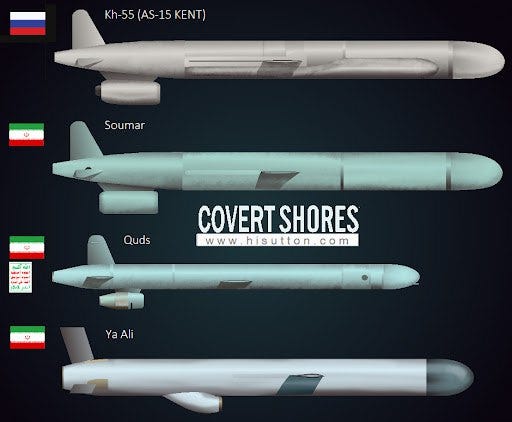
Then, following the appropriate time interval, Iran launched the coup de grace, its vaunted ballistic missiles. Here’s Iran’s own released footage of the start of Operation True Promise, which includes the ballistic launches:
As stated, all three layers of the attack were timed to coincide, with the slowest (drones) going first, then next fastest (cruise missiles), followed by the fastest time-to-target, the ballistic missiles.
The U.S. scrambled a large coalition to shoot the threats down, which included the U.S. itself, UK flying from Cyprus, France, and, controversially, Jordan which allowed them all to also use its airspace and even partook in the shoot downs.
Dozens of images proclaimed the “successful” shoot downs of Iranian ballistic missiles, like the following:
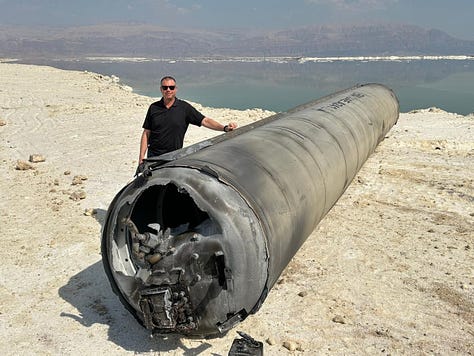
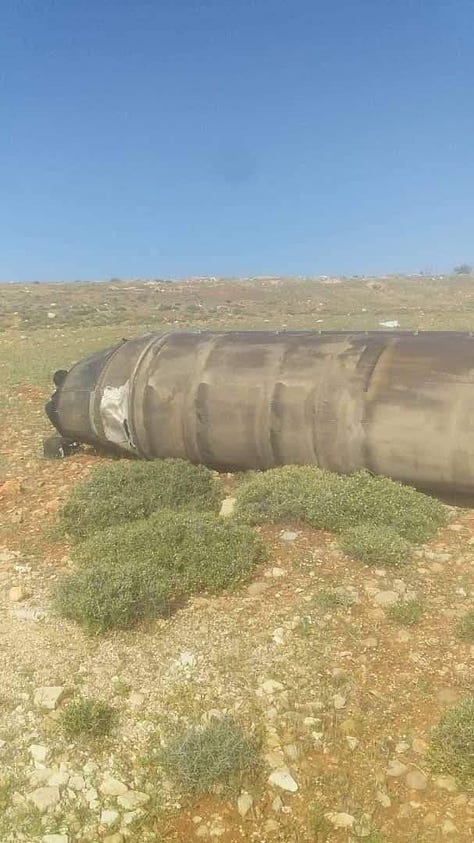
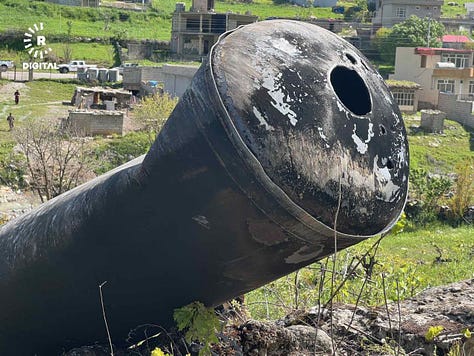
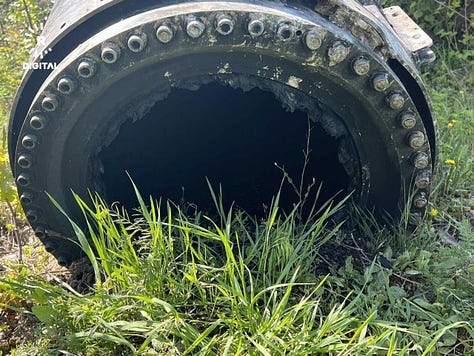
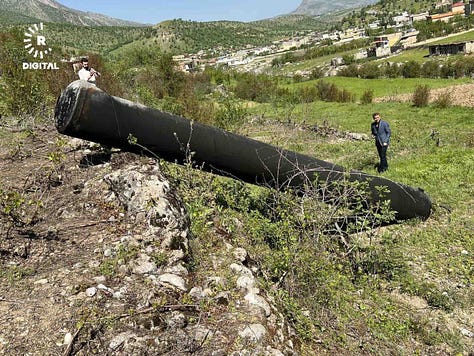
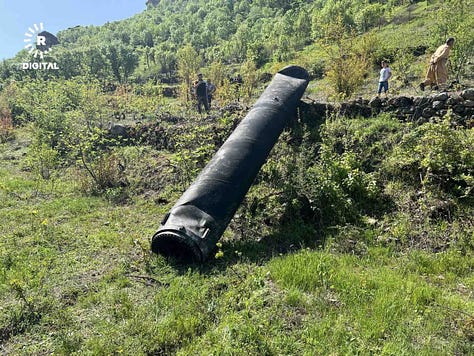
The problem is, all of those are the ejected booster stages of two-stage rockets. There is no conclusive proof that any ballistic missiles were shot down, and in fact all the evidence points to the opposite: direct footage of the missiles penetrating the AD net and striking targets. But we’ll get to that.
Missile Types
First: what kinds of ballistic missiles did Iran use?
There are speculations and then there’s what can be dutifully confirmed.
As for the confirmed, with my own eyes from the actual longer released launch video we can see the following:
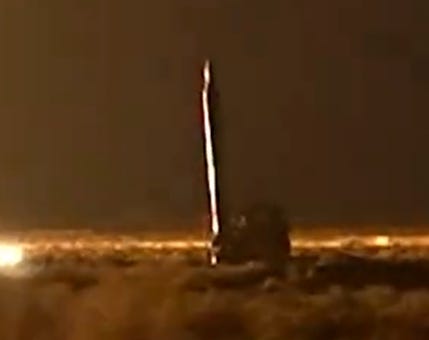
Which appears to match what is likely the Shahab-3 below:
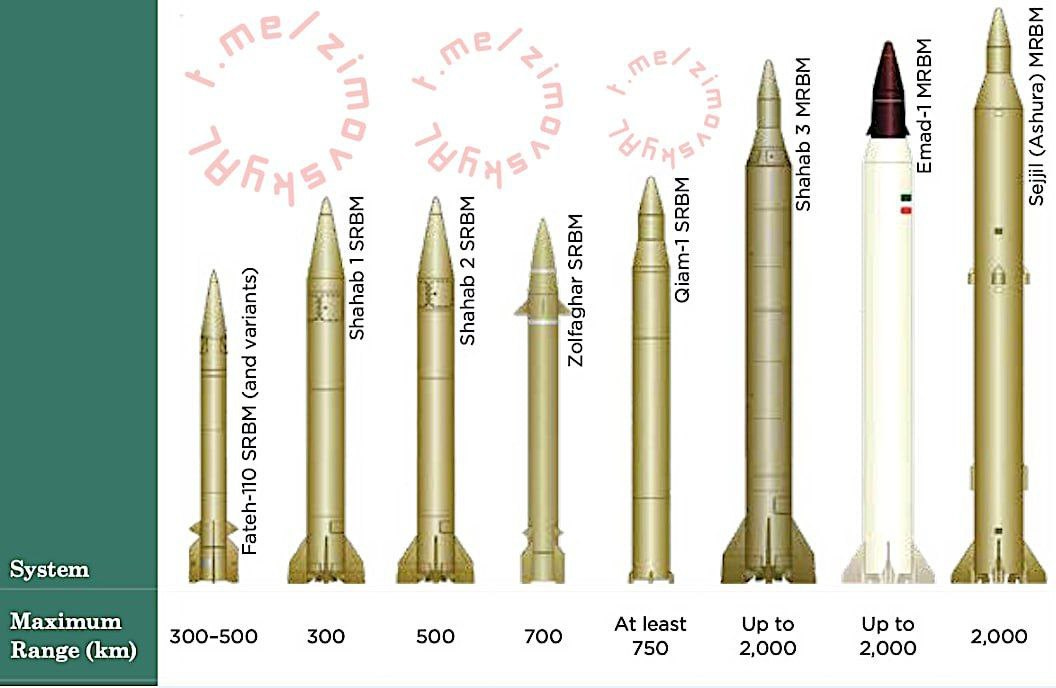
Here’s another photo from a Shahab-3 test:
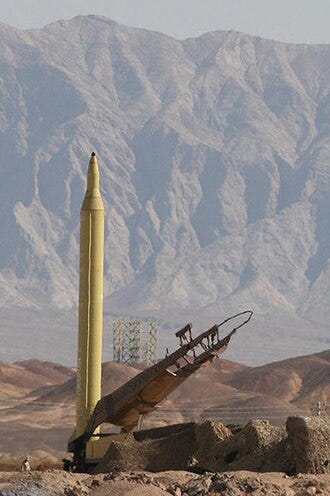
In the launch photo, the very top warhead nose cone does appear slightly shorter and may match the Sejjil rocket better. The Sejjil is in fact a much newer evolution of and upgrade to the Shahab that has both a two-stage and three-stage variety for an extremely long range of 2500km+. And some also claim it might be the Ghadr-110, but this is also an evolution and similar ‘upgrade’ of the Shahab-3 system, which likewise looks almost identical.
There are some other launch videos that appear to show possible Zolfagher or the updated Dezful systems as well.
Then there is the closest shot of the launch video, which gives us the most accurate confirmation of one of the missile types:


On the fuselage you can see what appears to be EMA written, and the same can be seen on this photo from today of a “downed missile” somewhere in Iraq:


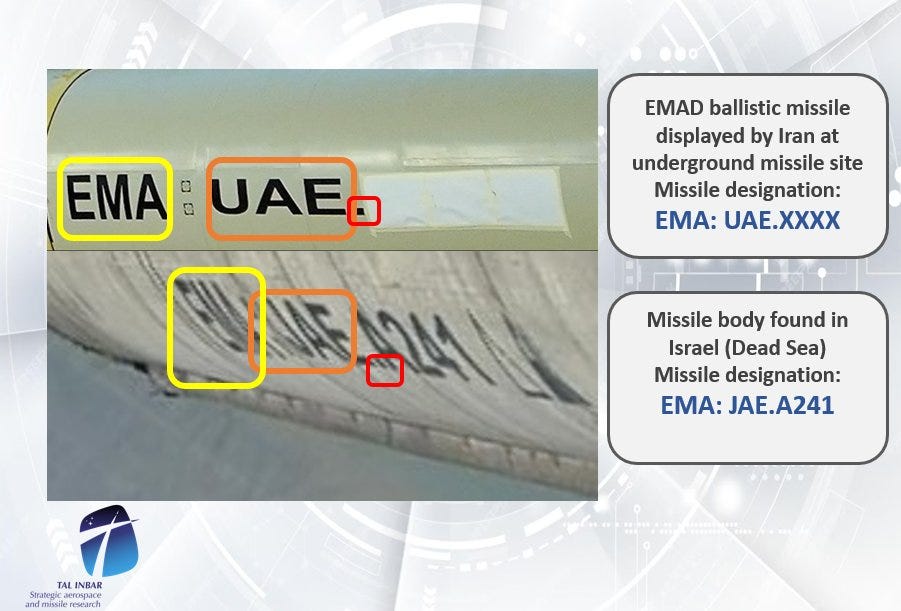
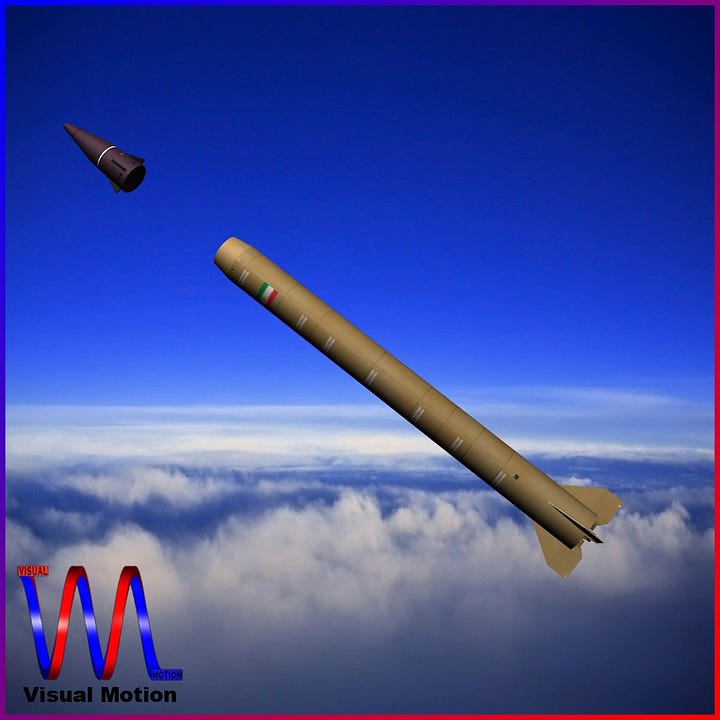
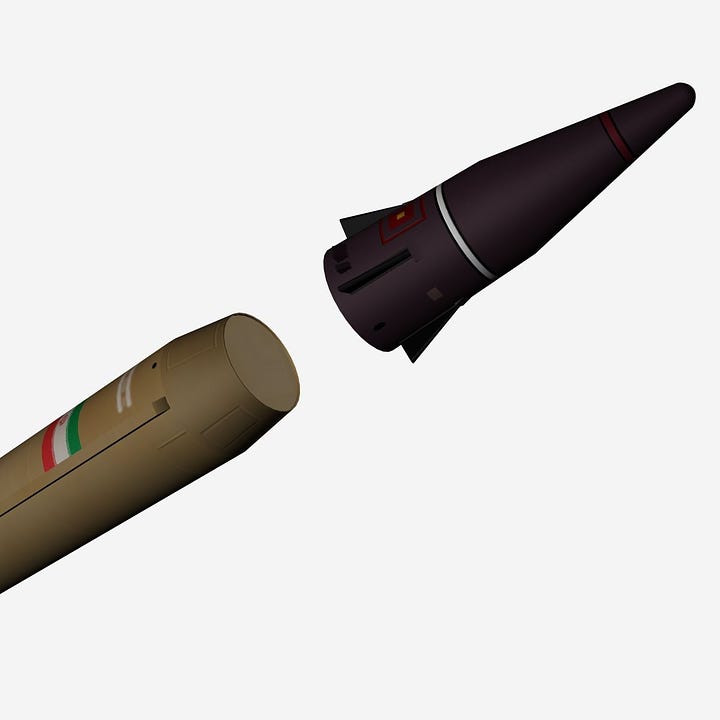
This comes closest to confirming that missile to be an Emad from the chart above, which is one of Iran’s most advanced and can feature a MaRV (Maneuverable Re-entry Vehicle) warhead. This is where it starts getting interesting, because the hits we saw in Israel appeared to potentially utilize some form of MaRV or hypersonic glide vehicle, which would mean Iran could have made history even beyond what we thought.
So let’s get there by first mentioning the other controversial claim that Iran possibly used its most advanced new hypersonic Fattah-2 system:

In none of the launch videos was this visible, but that doesn’t necessarily preclude Iran having secretly launched and tested some of the above. An Iranian academic stated the following:
“Iran has not fired its hypersonic missiles. In fact, most of the drones and missiles that were fired were older drones and missiles. They were very inexpensive and were used as decoys. So Iran spent a couple of million dollars to force the Israelis to spend $1.3 billion in anti-missile missiles, which was itself a big achievement by the Iranians. And then a number of other missiles that the Iranians fired…cut through and struck their targets,” the academic and geopolitical affairs commentator told Sputnik.
And lastly, there are some experts who believe Iran utilized its elusive hypersonic Kheybar Shekan missile, which also features a highly maneuverable MaRV.
These are two shots from last night’s launch video:
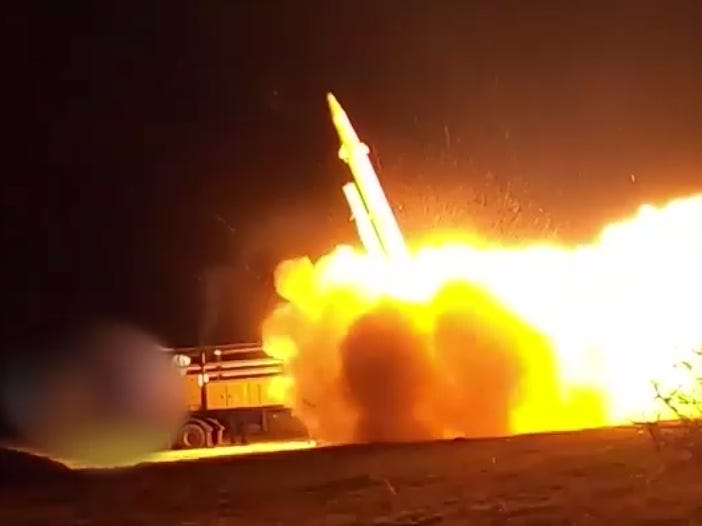
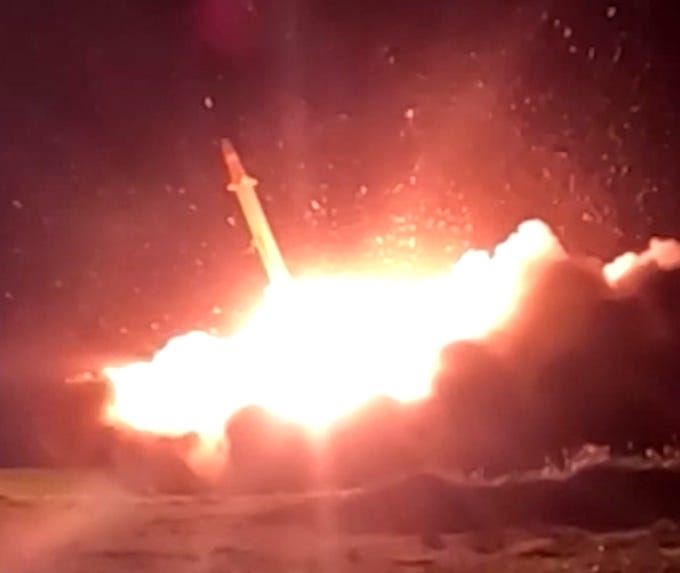
And here is a stock photo of the Kheybar nosecone and warhead:

This is where it gets most interesting, and why I’ve prefaced it so thoroughly.
In short: while Israel and the U.S. claim they shot down 100% of everything, and while it’s possible that the drone and cruise missile lures were mostly shot down—though we have no strong evidence one way or the other—we do have evidence that the ballistic missiles largely went unopposed, slicing through what’s claimed to be the densest air defense in the world. Not only Israel’s itself, comprised of a layered defense of David Slings, Arrow-3s, Patriots, and Iron Dome, but also the aforementioned allied airforces, as well as what’s now been reported to be a U.S. Arleigh Burke warship firing upwards of 70+ SM-3 missiles from the Mediterranean shore.
The hits that we saw were spectacular in one profound way: the terminal velocity of the Iranian ballistic missiles appeared stunningly fast. Let’s review some of the most exemplary videos.
Here’s by far the most revealing one, which totally refutes Israeli claims of 100% shoot downs. Note the massive swarm of air-defense missiles going up at the onset, then at the middle mark, watch as Iranian ballistics crash through the AD net totally unopposed at high speed, slamming into the ground:
As a quick aside, this next video was claimed by many to show Israeli Arrow-3 missiles shooting down Iranian ballistics in the exoatmosphere, i.e. in space:
But in reality, all it shows is the stage separation of the Arrow missiles as they climb toward the exoatmospheric zone. It does not show any actual successful interceptions, nor is there any evidence of a single ballistic missile being shot down.
But here’s where we get down to business. The next video is the most eye-opening in terms of the capabilities of these missiles. The two most important things to note are: 1) the terminal velocity right before impact and 2) note how some of the missiles strike very precisely onto the same location in groups.
First video, note the terminal speed here:
Here note the speed but also the grouping accuracy:
In particular at 0:31 above what looks like a runway on the rightside of the screen can be seen, which could indicate this to be the Nevatim airbase in the Negev desert—where Arabic speaking Bedouins live, which explains the Arabic in the video.
Not all the impacts exhibit the high speed of a potentially hypersonic re-entry vehicle. For instance, this video shows perhaps somewhat slower missiles that nevertheless are easily bypassing the joint Israeli-Western AD net:
But getting back to the hypersonic question. Here’s a video showing one of Iran’s missile tests, which appears to show one of the hypersonic glide vehicle style warheads from the Ghadr missile:
A new video of the moment one of the IRGC’s ballistic missiles was hit during last year’s solar exercise near Chabahar has been released with 60 frames per second, where you can clearly see the impact of the Ghadr missile warhead for the first time. This warhead also has a very good final speed around Mach 7 and will be very strategic. The three-cone body of this cap is completely and severely melted, and you can also see the burning marks on the small parts of this cap in the first frame of entering the frame.
Photo:

The speed appears to coincide with the videos of the faster strikes, and you can see the vehicle looks like it may be glowing white-hot, which could explain the somewhat odd fact that in all the strike videos, the Iranian missiles appear ‘red’ as if they are still burning their engines. But we know most ballistic missiles like the Iskander have a burn-out phase after which the engine stops burning. Thus the red-hot nature of the strikes could potentially indicate not a burning engine, but rather the heat of the vehicle’s outer skin from hypersonic re-entry.
Further, most ballistics strike on a pretty steep or straight down decline, while many of the Iranian hits are on a shallower trajectory which could indicate a glide-style vehicle, though in the above ‘test’ it clearly shows it coming down at a 90 degree angle, so it’s likely capable of both.
That being said, it may not be an unpowered glide vehicle but one of the thrust-capable re-entry vehicles like so:

Unfortunately, we just don’t know the exact details—like construction material for instance—that would allow us to fully confirm its terminal speed. However, based on visual eye-balling, some of the strikes appear to be landing at minimum Mach 3.5-5 if not higher, which according to some, is even higher than Iskander terminal velocity.
That being said, while the Iranian MRBMs feature very complex propulsion systems, given that they are two and even three stage for extra-long range, while Russia and the U.S. lacks these because of their previous adherence to the Intermediate Range Ballistic Missile Treaty, the guidance aspect of Iranian MRBMs remains a question mark. We don’t know how accurate they are, and in the end, how effective the strikes actually were in hitting their targets. That’s because beyond the general macro objective of “hitting Nevatim airbase”, for instance, we don’t know what precisely inside that giant airbase Iran may have targeted.
However, Israel did confirm the base was hit upwards of 7 times, but claims the damage was minor. In fact, they’ve now released footage showing them repairing one of the hit runways:
And some satellite photos have been released showing what appears to be possible strike damage throughout the base:


And another before and after timelapse, though unclear, shows possible damage to a hangar. Keep in mind this is the base which housed F-35s:
Could Israel be downplaying serious damage by releasing the video of a minor runway hole? For instance, they posted another video of an F-35 landing back at Nevatim base as a demonstration that the base is unharmed, but some have alleged that it is old footage:
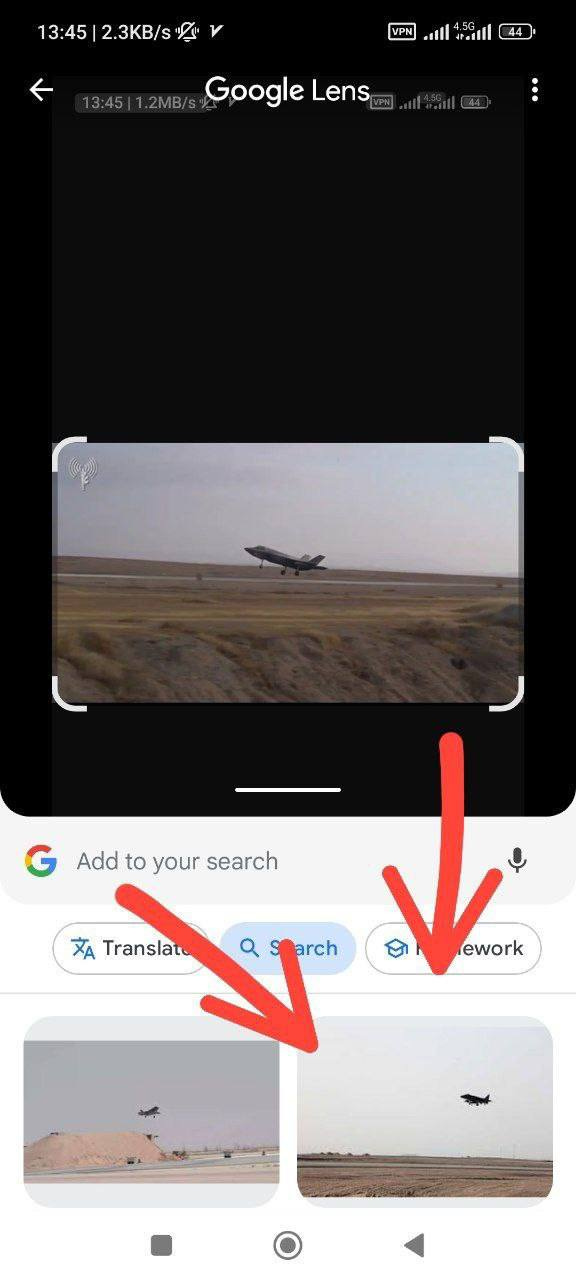
That’s not to mention the official Israeli account tried to pass off old footage of Russian MLRS launches from Ukraine as Iranian ballistic launches last night:
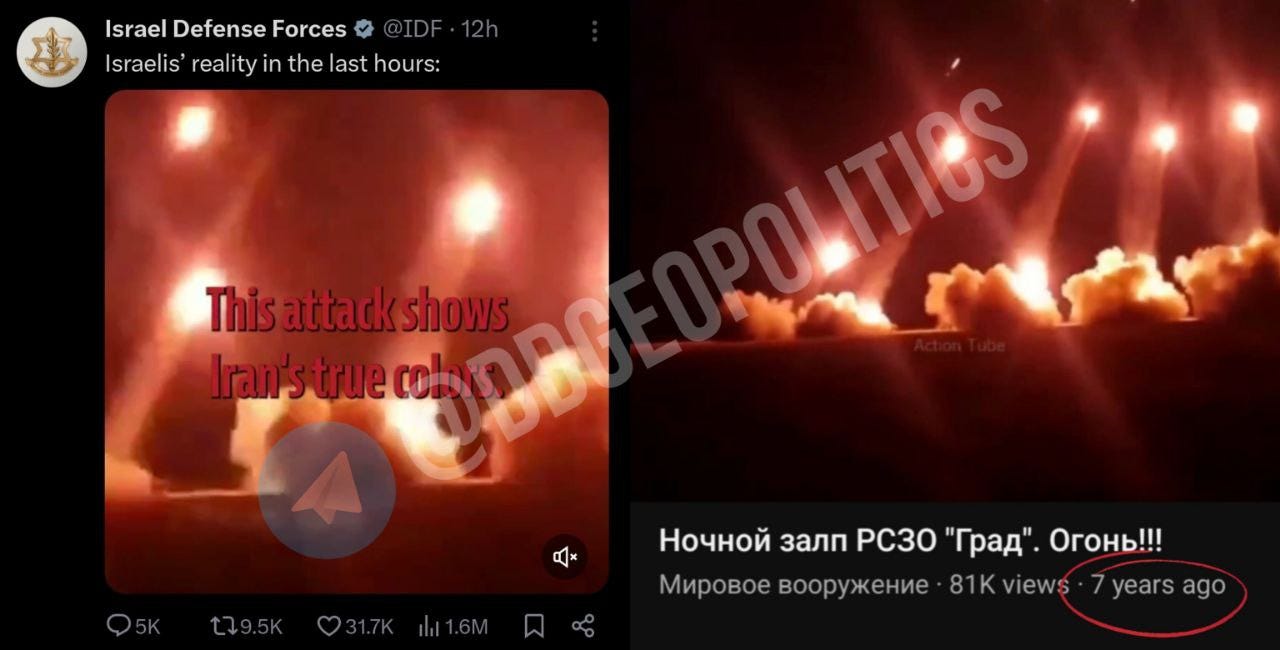
Thus it’s clear that truth is no obstacle for Israel, which means we certainly cannot take their word on anything regarding last night’s operation.
Conclusion?
What can we conclude about last night? We don’t have any definitive ‘final words’ on how effective Iran’s strikes were because:
- We don’t know Iran’s exact granular targets
- We don’t know Iran’s exact intentions
For the second, what I mean is that many now believe Iran merely strove to provide a ‘demonstration en force’, as Will Schryver puts it. A show merely as a ‘warning’ to Israel, and to create deterrence from future Israeli escalations. In fact, Iranian officials have now warned that Iran will respond similarly to all future Israeli attacks:

They call this the New Equation. Anytime Israel attacks them, Iran now intends to strike them ‘head on’, i.e. directly from its soil as is their newly demonstrated capability.
Beyond this, Iran broke new ground in setting new milestones for missile technology and modern warfare, as stated in the outset. Iran demonstrated the capacity to bypass the most powerful and advanced anti-missile systems in the world—ones that have no built-in excuse as is the case in Ukraine. In Ukraine, the excuse is that the Patriots and other systems are manned by under-trained Ukrainians, and are not reinforced and integrated as wholly into layered Western systems as they would be in Western hands.
But last night, Iran penetrated every missile shield manned and operated by NATO itself, with all the trappings and advanced C4ISR and SIGINT capabilities inherent to the entire Western alliance; from THAAD, to Patriot, David’s Sling, Arrow-3, SM-3, Iron Dome, and even ‘C-Dome’ from Israeli corvettes—not to mention the entire complement of the West’s most advanced A2A defenses flown from F-35s, Typhoons, Eurofighters, and likely much more.
One must understand that ballistic missiles are precisely the apex predator that these most advanced Western AD systems were created to handle—and last night, they failed spectacularly in the same way the Patriots did in Desert Storm before them:


This sends a signal that Iran is now truly capable of striking any of the most high profile, high value targets of the West’s, in the entire sphere of the Middle East, within a radius of 2000-4000km. That is a significant capability that dwarfs even anything Russia or the U.S. itself is capable of in the same efficient way. Sure, Russia can send Avangards (very few, and highly expensive) and far slower long range cruise missiles, but due to the Treaty, no other country can match Iran’s cheap and immediate ballistic missile capability. The U.S. would have to send up a load of slow planes and do the traditional long range stand off attacks with slow munitions to hit targets at such distances.
As I said, the only question that remains is still of effectiveness by way of accuracy. It’s one thing to develop long range rockets via the luxury of a two-stage allowance, but there’s far more technology that goes into making such objects critically accurate—and I suspect here Iran may fall short of Russia and the U.S.’ capabilities, given that there’s a whole host of special electronics (signal boosting, EW reflecting, etc.) and guidance redundancies that are required for extreme accuracy. This is where Russia’s systems shine. Iran’s missiles have been shown to be quite accurate during tests in Iran under ideal conditions—but in highly contested EW environments, when the GPS/Beidou/Glonass signals are jammed, it could be a completely different story. Furthermore, the science behind signal retention in hypersonic plasma bubbles is quite extreme and no country has yet even proven the capability to consistently do this—but we won’t get into that for now, as I may cover that in an upcoming article focusing on the Russian Zircon.
The optics of seeing Iranian missiles flying over the Israeli Knesset surely sends chills down Israel’s spine because it states: we could have easily destroyed your Knesset, and much else, but we chose to be lenient, for now:
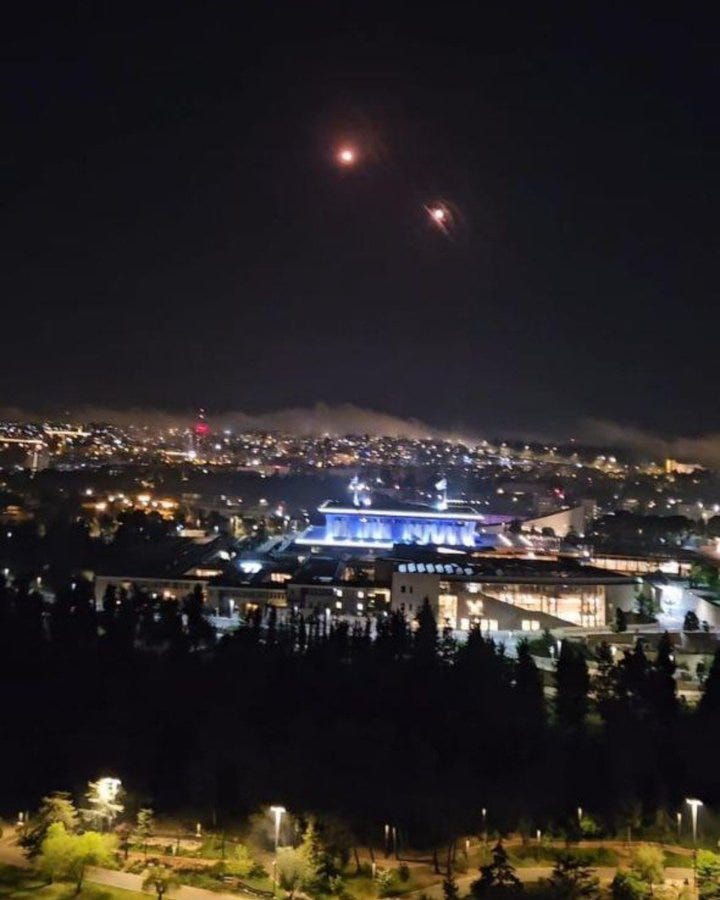
Who came out the winner?
There are now two chief competing ‘takes’ on the situation.
One says that Iran was ‘humiliated’ as Israel intercepted everything, and more importantly, that Iran has now blown its only advantage of surprise and strategic uncertainty/ambiguity by ‘showing its hand’ and not achieving much. They argue that Iran’s one true advantage over Israel was the threat that it could effect a mass launch of its feared ballistic missiles, wiping out huge swathes of Israel. But now that the perceived ‘damage’ from the attack was low, Iran has shown itself to be weaker than expected, which could imbue Israel with even more courage and motivation to continue striking and provoking Iran, as they might see they have nothing to fear from Iran’s long-touted missiles.
This is certainly a reasonable argument. I’m not saying it’s totally wrong—we simply don’t know for a fact because of the aforementioned reasons that:
- We don’t actually know how much damage the strikes caused, due to Israel’s obvious lies of “100% interceptions” and disproved fakes.
- We don’t know whether it was merely Iran’s goal to do a ‘light’ showing in the interest of ‘escalation management’. I.e. they may not have wanted to cause too much damage deliberately, simply to send a message but keep from provoking Israel to respond too aggressively.
Iran is said to have thousands of such missiles, so obviously having launched only 70+ or so is likely not indicative of a major attack tasked with actually causing serious destruction to Israeli infrastructure.
Then there’s the converse side: Iran came out the big winner by demonstrating all the previously-outlined abilities of bypassing the West’s densest AD shields.
Here’s why I think in some ways this conclusion to be the more correct in the long term.
Firstly, one of the common counterarguments is that Israel possesses nuclear weapons, which ultimately trumps anything Iran can throw at them. But in reality, now that Iran has proven the ability to penetrate Israel, Iran too can cause nuclear devastation by striking the Israeli Dimona nuclear power plant. Destroyed nuclear plants would produce far more radioactive chaos than the relatively ‘clean’ modern nuclear weapons. Furthermore, Israel is much smaller than the comparatively gigantic Iran. Iran can take many nuclear hits and survive; but a single mass nuclear event in Israel could irradiate the entire country, making it uninhabitable.
Secondly, recall the main fear of Iraqi Scarabs and Scuds back in the day: that they could contain chemical/biological warheads. Iran too could technically load its missiles with all kinds of nasty goodies of this sort: either chem-bio or even unenriched Uranium—which it has aplenty—to create a ‘dirty bomb’. Now that we know it can penetrate Israel easily, Iran could actually wipe the country out with a mass un-enriched nuclear, chemical, or biological attack with these now-proven hyper- or quasi-hypersonic ballistics. That threat alone now presents a psychological Damocles Sword that will act as asymmetrical deterrent or counter to any Israeli Samson Option threat.
Thirdly, this was Iran’s very first foray into such a direct strike. It can be argued that they gained critical data and metrics from the entire Western alliance’s defensive capabilities as well as Israeli defensive vulnerabilities. This means that there is an implied threat that any future attack of this scale could be far more effective, as Iran may now ‘calibrate’ said attack to maximize what it saw were any failings or weaknesses on its part last night. Russia has had two years of launching such strikes, and it has only been semi-recently that they’ve calibrated and finetuned the precise timings of the sophisticated multi-layered drone-ALCM-ballistic triple threat attack. Iran can improve with each iteration as well and maximize/streamline the effectiveness with each attempt.
Fourthly, there is the now-confirmed mass discrepancy of operational costs:
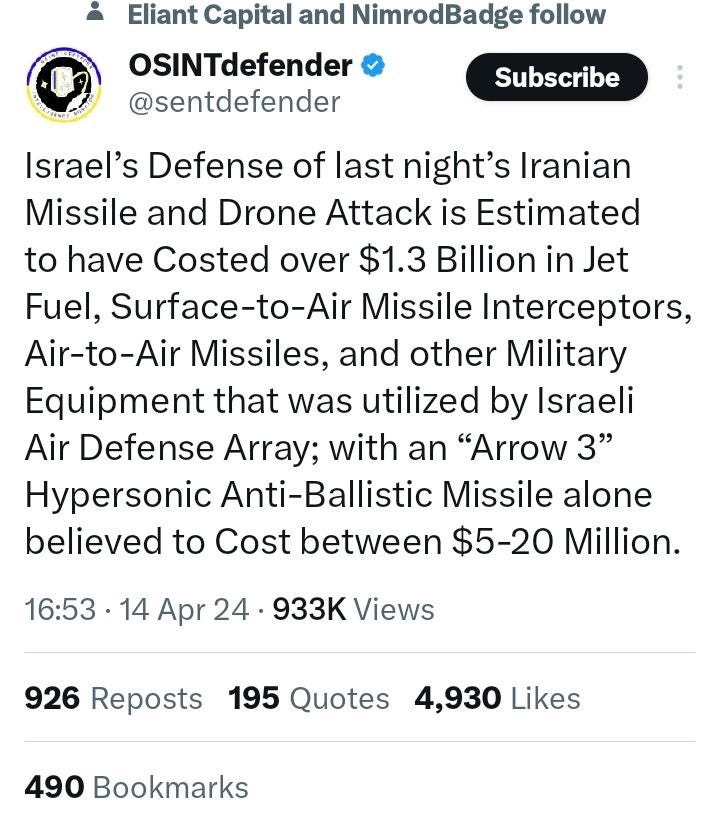
Israel’s defense of last night’s Iranian missile and drone attack is estimated to have costed over $1.3 billion in jet fuel, surface-to-air missile interceptors, air-to-air missiles, and other military equipment utilized by the Israeli air defense array; with an “Arrow 3” hypersonic anti-ballistic missile alone believed to cost between $5-20 million.
One unconfirmed source claimed Iran’s attack cost as little as $30M, while the number floated for the West’s interceptions is around $1B to $1.3B.
Given that the average interceptor missile is minimum from about $1M to upwards of $15-20M for the SM-6s, this total price is plausible. Given that Iran was said to have fired a total of ~350+ drones/missiles, and that the standard procedure is to fire 2 interceptors at each threat, one can clearly see the math: 350 x 2 = 700 x $1-15M.
The point is that, just as we’re in the midst of the Houthis having proven the West’s total inability to sustain defense against mass persistent drone swarms, here too Iran may have just proven an absolutely lethal inability of Israel and the West to sustain against a potential long drawn-out Iranian strike campaign; i.e. one prosecuted over the course of days or weeks, with consistent daily mass-barrages. Such a campaign would likely critically deplete the West’s ability to shoot down even the lowest scale Shahed drone threat. Just look at Ukraine—it is going through the same lesson as we speak.
Lastly, what does this mean?
One neglected consequence of this is that Iran now stands to field the ability to totally disrupt Israel’s economic way of life. If Iran were to engage in a committed campaign of mass strikes, it could totally paralyze the Israeli economy by making entire areas uninhabitable, causing mass migrations in the same way the Hamas attack led thousands of Israelis to flee.
Unlike Israel’s barbaric and savage genocide aimed primarily at civilians, last night’s Iranian attack exclusively targeted military sites. But if Iran wanted to, they could launch mass infrastructure attacks in the way Russia has now done to Ukraine’s energy grids, further compounding the economic damage. In short: Iran could mire Israel in months’ and years’ long economic malaise or outright devastation.
Don’t forget this attack was still relatively limited to Iran alone. Sure, the Houthis and even Kata’ib Hezbollah reportedly sent a few drones, but it was minor. That means in the future, should Israel choose to escalate, Iran still reserves several levels of its own escalatory advantage. If push came to shove, imagine Hezbollah, Ansar Allah, Hamas, Syria, and Iran all launching full-fledged attacks on Israel in all out war. Maybe that’s what Israel wants, some would argue. After all, there are echoes of the various Arab-Israeli wars where Israel ‘triumphed’ against such large Arab coalitions. But times have changed, the calculus is slightly different now. Short of using nuclear weapons, how would Israel survive a full-scale war against Hezbollah in the north while Iran rains daily barrages of hypersonic missiles, drones, and everything in between on Israel’s industries, crippling its economy?
Of course, at that point the question of the U.S. coming to help is brought up, but, clearly desperate for an off-ramp, Biden just stated:

An Important Overlooked Point
The final aspect for consideration is to remember that all of the preceding and ensuing events could very well be part of the Israeli plan. Recall, Israel didn’t choose to blow up the Iranian embassy—a huge, unprecedented maneuver—and slaughter Iranian generals just for its health. This appeared part of a clear strategy of escalation aimed at baiting Iran into an escalatory spiral, presumably with the end goal of drawing the U.S. into a large scale war to cut down Iran once and for all.
In light of that, some experts now speculate that Iran foolishly “fell into the trap”. However, as stated earlier, Iran can be said to have wisely ‘managed’ the escalation for precisely this reason: to show its strength while not going too far in a way that would invite a wider American response—or even an Israeli one for that matter.
But I simply mention this to temper any ‘celebratory’ touts from the resistance sphere. While Iran’s strikes may inspire some chest-beating chauvinism, in reality it may very well have played into Israel’s hand. However, the U.S.’ unwillingness to support Israel into further escalation could very well deflate Netanyahu’s goals and simply leave Israel with egg on its face with Iran coming out the winner in the exchange.
We’ll have to wait and see where it leads: as of this writing, the story has changed three separate times; the last two being that Israel decided not to respond, with news now claiming that Israel not only has chosen to retaliate, but will even do so as early as tonight, perhaps within minutes or hours of this publication’s release. If that turns out to be the case, then we’ll have to see if Israel chooses its own ‘face-saving’ off-ramp ‘light touch’ attack just for damage control’s sake, or whether it truly aims to keep climbing that escalatory ladder in force. Any major action without American backing is risky: not only because it could fail, and Israeli planes could be shot down, but also because Iran could make good on its word and unleash another far more devastating attack.
Final Thoughts
Why now? Why did Israel bait Iran into such an action at this precise moment?
The clue to the answer lies in the news from several days ago that Israel totally withdrew its forces from Khan Younis:


I suspect that Israel—or Netanyahu in particular—is facing failure, after not having accomplished any of the stated objectives, and thus is desperate to create a new distraction as a vector for continuing the war in some way that could keep the world, and Israelis, from reaching the conclusion that the war has been totally lost.
Have you seen the latest bombshell from Haaretz?
We’ve lost. Truth must be told. The inability to admit it encapsulates everything you need to know about Israel’s individual and mass psychology. There’s a clear, sharp, predictable reality that we should begin to fathom, to process, to understand and to draw conclusions from for the future. It’s no fun to admit that we’ve lost, so we lie to ourselves.
Some of us maliciously lie. Others innocently. It would be better to find solace in some airy carb with a total-victory crust. But it might just be a bagel. When the solace ends, the hole remains. There’s no way around it. The good guys don’t always win.
The astonishing article, which jibes with the sentiments of many Israelis, goes on:
After half a year, we could have been in a totally different place, but we’re being held hostage by the worst leadership in the country’s history – and a decent contender for the title of worst leadership anywhere, ever. Every military undertaking is supposed to have a diplomatic exit – the military action should lead to a better diplomatic reality. Israel has no diplomatic exit.
The article concludes that the calculus has changed, and that Israelis may now never be able to return to the northern border, given the situation with Hezbollah.
Another classic line:
No cabinet minister will restore our sense of personal security. Every Iranian threat will make us tremble. Our international standing was dealt a beating. Our leadership’s weakness was revealed to the outside. For years we managed to fool them into thinking we were a strong country, a wise people and a powerful army. In truth, we’re a shtetl with an air force, and that’s on the condition that its awakened in time.
The author then focuses his condemnation on the upcoming ‘Rafah operation’:
Rafah is the newest bluff that the mouthpieces are plying to fool us and make us think that victory is just moments away. By the time they enter Rafah, the actual event will have lost its significance. There may be an incursion, perhaps a tiny one, sometime – say in May. After that, they’ll peddle the next lie, that all we have to do is ________ (fill in the blank), and victory will be on its way. The reality is that the war’s aims will not be achieved. Hamas will not be eradicated. The hostages will not be returned through military pressure. Security will not be reestablished.
In short: this is why Netanyahu needed an escalation. It’s to divert attention from the ongoing catastrophe of Israel’s potential defeat to Hamas, the catastrophic loss of standing of Israel’s image in the world community, the complete turning against Israel by the entire world. Rather than admit defeat and face the end of his career, as well as the coming trials and tribunals that would put Bibi in jail, he chose to take the only remaining option: to continue escalating in the hopes that a wider-scale war could wash away his sins and undo the past mistakes. Unfortunately, just like the ill-fated Zelensky, Netanyahu’s doomed plan appears destined to coincide with the U.S.’ historic decline, reaching its zenith now in this pivotal year of 2024.
At the critical moment when Israel needed the strongest possible America, they got the weakest America in its history. That is Israel’s blunder, which may be its ultimate, calamitous undoing. But Bibi will likely have no choice but to continue escalating, or at least keep a strategy of tension a constant presence in order to survive.
Only last quick postscript note is to say that the ensuing events could affect the Ukrainian aid bill, as there is now talk of ramming through an emergency Israeli aid package, in light of events, which could have Ukrainian aid attached; but we’ll have to see what happens, as there is still strong opposition among some Republicans.
___
https://simplicius76.substack.com/p/iran-breaches-anglo-zionist-defenses?utm

